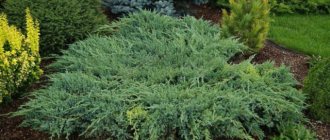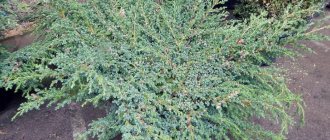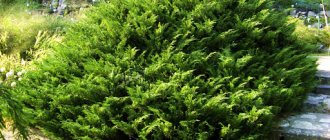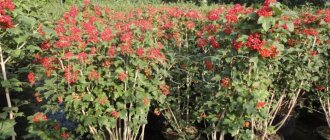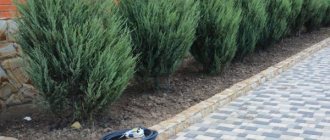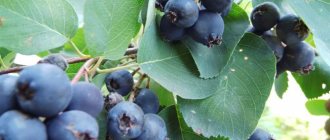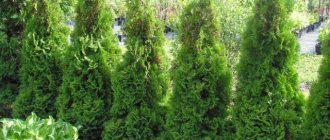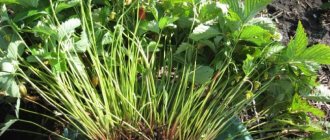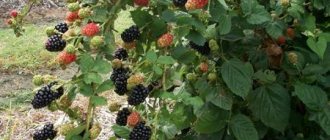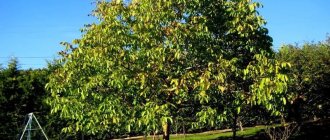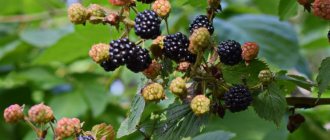Author: Natalya Category: Garden plants Published: February 25, 2019Republished: February 25, 2019Last edits: November 04, 2020
Rock juniper (lat. Juniperus scopulorum) is a species of the Juniper genus of the Cypress family. Under natural conditions, rock juniper grows in the USA (Oregon, western Texas, northern Arizona), Canada (British Columbia and southwestern Alberta), and northern Mexico, choosing rocky mountain soils at an altitude of 1200 to 2700 meters above sea level. seas. In cultivation, rock juniper is still rare.
Planting and caring for rock juniper
- Planting: early spring, before sap flow begins.
- Lighting: bright sunlight.
- Soil: for dwarf varieties, poor soil is preferable; for large plants, fertile soil is preferable, in an area with deep groundwater.
- Watering: Young plants are watered regularly and abundantly, and adults - only during periods of prolonged drought; no more than three waterings are carried out in total during the season. In the evenings, in hot, dry weather, the juniper crown is sprayed with non-cold water once or twice a week.
- Fertilizing: in April-May, a solution of Nitrofoski or Kemira-universal is applied to the tree trunk area of young plants, but adult plants do not need fertilizing. Organic fertilizers are contraindicated for rock juniper.
- Pruning: the formation of the crown of rock juniper does not require, and sanitary pruning is carried out on a cloudy spring day before the sap begins to flow.
- Reproduction: semi-lignified cuttings, grafting or young layering.
- Pests: aphids, leafminer moths, spider mites and scale insects.
- Diseases: rust, tracheomycosis, fusarium wilt, drying out of branches, brown chute.
Read more about growing rock juniper below.
Diseases and pests: treatment methods
Juniper often suffers from rust. The disease manifests itself in the form of red-colored growths, which contain an oily liquid. The plant begins to dry out and soon dies. At the first signs of the disease, it is necessary to cut and burn all infected branches and treat them with fungicide, Bayleton, Skor and other similar preparations.
Constant waterlogging of the soil can lead to Fusarium wilt. With this disease, the apical shoots become dry and pale red. To stop the spread of fusarium, you should remove the affected areas and treat the branches, trunk and soil underneath with a fungicide, Quadris or Fitosporin-M.
A fairly common disease is the so-called drying out of branches. Symptoms can be detected in the spring: the needles turn yellow, and sometimes small fruiting bodies of fungi appear on the bark. To save the bush, you need to cut off the diseased shoots and spray with medicine. Severely affected specimens must be destroyed. For prevention, it is recommended to treat plants with Tilt, Ridomil Gold MC or Skor in mid-spring and at the end of October.
Another ailment to which rock juniper is susceptible is brown schutte. Because of this disease, the needles turn yellow and fall off, and this happens at the very beginning of June. Dampness and lack of sunlight can aggravate the process. Sanitary pruning (it is also recommended to collect all fallen needles) and treatment with Quadris, Skor or Strobi will help to cure the bushes. Preventative spraying should be carried out in mid-April and before the onset of autumn cold weather.
Pests that are interested in conifers include leafminer moths, scale insects, aphids and spider mites. Getting rid of them is not difficult if you choose the right product. Phytofarm works well against aphids. The mole will drive away the Decis solution. Spider mites and scale insects do not tolerate Karbofos and other acaricides. It should be remembered that to effectively combat insects, you need to treat not only the bush itself, but also the soil under it.
Botanical description
Representatives of the species are dioecious trees or shrubs. The height of rock juniper can reach from 10 to 18 m with a trunk girth of 80 cm to 2 m, but in cultivation the plant is usually lower and thinner. The crown of the juniper starts almost from the base and has an irregular conical shape, which becomes rounded with age. The bark of the tree is brown, the shoots when young are bluish-green or light blue. Opposite, ovate-rhombic, mostly scale-like, up to 2 mm long and up to 1 mm wide, the leaves of rock juniper are colored bluish-green, dark green or blue-gray. The needle-shaped needles found on rock juniper reach a length of 12 and a width of 2 mm. Dark blue spherical cones with a blue bloom, 4 to 6 mm long, ripen by the end of the second year. The fruits contain reddish-brown ribbed seeds up to 5 mm in diameter.
Rock juniper: varieties for middle latitudes
- Blue Arrow - The height of the bushes of this variety reaches 2.5 meters. Its crown has the shape of a column 50 centimeters wide. The branches are covered with scaly needles that resemble needles. It also has a greenish-blue color with a hint of steel.
- Blue Haven - The plant can grow up to 2 meters in height. The crown is in the shape of a pyramid, no more than 1 meter wide. The needles are light blue in color and have a steel tint.
- Skyrocket - This variety is capable of reaching 6 meters in height. It is highly resistant to winter cold. The stems are covered with needles, like green scales. They fit tightly to the trunk, which makes the plant very narrow and graceful. The variety has low resistance to fungal diseases.
- Moffat Blue - This variety can reach 6 meters in height. It is highly resistant to winter cold. Its dense crown resembles a pyramid about 1.3 meters wide. The needles are colored green with a blue tint. Not suitable for growing in regions with high humidity.
- Moonglow - This variety has similar characteristics to Blue Haven. It has a crown in the shape of a wide pyramid. The height of the plant reaches no more than 2.5 meters. Width no more than 1 meter. The needles are painted in bright shades of blue with a silver tint. Colors look especially beautiful in winter, becoming their brightest.
- Silver King - The branches of this plant are spread out. The height of the bush does not exceed 60 centimeters. But its width can reach 2 meters. The needles, resembling scales, are colored blue.
- Springbank - Bushes of this variety reach 4 meters in height. It differs from others in its disheveled branches on the crown, reminiscent of a pillar. Thin needles are blue with a hint of silver.
- Table top blue - The variety has an oval shape. The maximum height does not exceed 2 meters. Width about 2.5 meters.
- Welch - The variety has a dense crown in the shape of a pyramid. The needles are colored green with a hint of blue and a silver tint.
- Wichita Blue - The outstretched branches of this plant are blue with a silver tint. The maximum height that the plant reaches is no more than 40 centimeters. While the width can reach one and a half meters.
Gardeners also use such varieties as: Winter Blue, Tollesons Blue Whipin, Tollesons Green Whipin, Sutherland, Monwade, Medora, Greenspier, Erect Glauca, Gray Glim, Colorado Green.
Planting rock juniper
Rock juniper planting material with a closed root system can be planted in the ground during the entire growing season, but if the root system of the seedling is open, then the best time for planting is early spring, the period between the soil warming up and the start of sap flow.
Planting and caring for juniper in open ground
Planting rock juniper and caring for it will not be difficult if you follow the agrotechnical conditions of the crop. When choosing a place to plant a plant, you should prefer open sunny areas with deep groundwater. Large varieties are more suitable for fertile soil, while dwarf varieties grow better in poor soil, otherwise they cease to be stunted. It should also be taken into account that rock juniper needs a lot of space.
- Tenacious: growing from seeds, types and varieties
The planting pit for rock juniper should be at least twice as large as the root system of the seedling. Dwarf varieties of plants are planted at intervals of half a meter, and the distance between seedlings of tall varieties should be at least 2 m: after 10 years the bush will begin to grow rapidly. A twenty-centimeter layer of broken brick or crushed stone is laid at the bottom of the planting pit. Before planting, it is advisable to immerse the roots of the seedling in a container of water for several hours: this will allow you to remove the plant from the container with minimal stress on it. If you manage to keep a ball of earth on the roots of the seedling when planting, it will be much easier for it to adapt to the new place.
Place the seedling in the hole, straighten its roots and fill the pit with a soil mixture of turf soil, peat and sand in a ratio of 1:2:1. After planting, the seedling should be watered abundantly, and when the water is absorbed, its tree trunk circle is mulched with a layer of sawdust, wood chips, pine bark or peat 8 cm thick. Please note that as a result of planting, the root collar of the seedling should be at ground level.
Features of agricultural technology
Landing
Chinese juniper: the best varieties, description, planting and cultivation
Bushes with a closed root system can be planted all year round. Planting seedlings with bare roots into open ground is carried out only after the arrival of spring and sufficient heating of the soil, without waiting for the start of sap flow. If you follow the rules of agricultural technology, caring for the tree will not be difficult.
When choosing a place for planting, you need to prefer a sunny open space. You should ensure that the distance to groundwater is at least about 10 meters. For low-growing varieties, you need to choose poor soils, otherwise the dwarf property will remain aside. Full-fledged species are grown in nutritious soil in open areas.
When choosing a place for planting, you need to prefer a sunny open space
Please note! The size of the hole for the tree should be at least 2 times the volume of the root system. Dwarf varieties are planted at intervals of 50 cm. For tall representatives of the crop, a larger distance is needed, taking into account the annual increase not only in height, but also in crown volume.
First of all, the bottom of the pit is covered with a drainage layer; its thickness should be at least 20 cm. You can use broken stones, brick or crushed stone. Next, the bush is lowered into the planting hole, covering everything with a mixture of peat, turf soil and sand (proportion 2:1:1). Now the newly planted bush needs to be watered abundantly and wait until the moisture is completely absorbed.
The mulch layer should be at least 8 centimeters and consist of peat, wood chips, sawdust or pine bark. When planting a tree, you need to pay attention to ensure that the root collar after planting is flush with the ground surface.
The mulch layer should be at least 8 centimeters
Important! To carefully remove the seedling from the pot, first, a few hours before planting, the pot must be placed in a container of water. This way, the tree can be removed from the container without damaging the roots. All this will help the plant take root better.
Care
For the most part, climbing shoes are valued precisely for their unpretentiousness. At the same time, you need to understand that, regardless of the care provided, the growth of the tree slows down in the first years. For full development, newly planted juniper is watered several times a month, provided there is no natural precipitation. Additionally, it is recommended to spray the bushes with warm water, exclusively in the evening. Adult representatives are watered only during periods of drought, and they can be moistened no more than several times during the season.
It is strictly forbidden to use organic fertilizers to feed juniper. For young trees, one feeding is enough, carried out during the transition period from April to May. For 1 bucket of water use 20 grams of Kemira-universal or add nitroammophoska at the rate of 30-40 grams per square meter. Plants that have taken root do not require fertilizer.
Kemira all-rounder
The need for care in winter may be determined by the characteristics of the variety. For columnar trees, it may be necessary to clear snow from the branches to protect them from damage under the weight. Also in the fall, you can tighten the branches, pressing them against the trunk, so that the crowns do not break from heavy snowfalls.
Diseases and pests
Coniferous trees suffer most from fungal infections. Diseases and pests that juniper suffers from:
- Rust is a fungus that appears as deep orange growths. To combat it, the affected areas are cut off and treated with any fungicide;
- Tracheomycosis (Fusarium wilt) is a disease of the root system associated with waterlogging of the soil. It is recommended to replace the top layer with fresh soil, cut off the affected parts, spray the surface of the soil under the top layer with fungicides against fungal infections;
- Drying of the branches - the needles begin to die, turn yellow, and small fruit mushrooms begin to cover the trunk. For treatment, the affected branches and other areas are removed, and the entire tree is treated with fungicides.
Caring for rock juniper
Growing in open ground
Rock juniper is undemanding in care and resistant to urban conditions, but it grows slowly, especially in the first years.
Watering an adult juniper is carried out only during periods of prolonged drought, no more than three times a season, but newly planted plants need more frequent watering. The seedlings also respond well to evening spraying with warm water.
As for fertilizers, organic matter is contraindicated for juniper, so for young plants in April-May one fertilizing with Nitroammophoska (30-40 g per m²) or Kemira-universal (20 g per 10 liters of water) will be enough. Mature plants do not need fertilizers.
The behavior of rock juniper in the cold season depends on the variety. Plants with a columnar crown after heavy snowfalls need to be shaken off from snow, under the weight of which their branches may break. To avoid such injuries, it is better to tie the branches with twine on the eve of snowfalls, pressing them to the trunk.
Transfer
Improper transplantation of juniper can lead to its death as a result of damage to the root system. Large adult specimens are especially affected. How to replant a plant correctly to avoid unpleasant consequences? When digging up juniper, it is extremely important to preserve the earthen ball in which the root system of the plant is located.
It is better to replant rock juniper during the period when it has maximum root-forming ability: in March-April or June-July. However, summer is not the best time for this procedure, because in the heat the needles evaporate too much water, which greatly weakens the plant and slows down the adaptation process. Based on this, the best time to replant rock juniper is spring, but if absolutely necessary, it can be replanted during leaf fall.
Growing Cossack juniper in open ground
First, dig a planting hole with the required parameters, taking into account the size of the earthen ball, and lay a drainage layer in the pit. Then prepare the soil mixture to fill the hole. And only after this they dig up the juniper in a circle, stepping back at least half a meter from its trunk, remove the plant with a lump of earth, lay it on a piece of dense film or fabric, transfer it to the planting hole and complete the process in the same order as during the initial planting. Don’t forget to mulch the tree trunk and protect the juniper from direct sunlight for the first time.
Pests and diseases of rock juniper
Most often, juniper is affected by rust, a fungal disease that is manifested by the formation of bright orange growths on the branches of the plant containing oil with a pigment close to carotene. A diseased plant loses its decorative appearance, its branches dry out and within a few years the juniper dies. When signs of rust appear, it is necessary to trim and destroy the affected branches and shoots, since they can no longer be cured, and the juniper should be treated with a fungicide. Do not forget to disinfect the tool before and after pruning. For preventive purposes, several treatments of juniper with fungicides should be carried out from spring to autumn. The best therapeutic and preventive effect was shown by the drugs Rogor, Bayleton, Vectra, Skor and Tilt.
Another common juniper disease is tracheomycosis, or fusarium wilt, which most often develops in too dense soil under conditions of high humidity. Tracheomycosis affects the root system of the juniper, and nutrition ceases to flow from the roots to the ground organs, as the fungal mycelium grows into the vascular system of the plant. As a result of the development of the disease, the apical shoots of the juniper begin to dry out, the needles of which acquire a reddish tint, and then the disease consumes the entire plant. It is almost impossible to detect tracheomycosis at an early stage, but as soon as you see that the rock juniper has turned yellow or red at the tops, cut off the affected branches, thoroughly treat the plant and the soil underneath with fungicides, but it is best to replace the top layer of soil in the trunk circle with fresh soil mixture , soaked in a fungicide solution. For preventive purposes, purchased planting material should be treated together with an earthen ball with Fitosporin-M, Quadris or Maxim, and the root system of smaller seedlings should be placed entirely in Maxim’s solution for 2-3 hours.
A serious disease of juniper is the drying out of branches, which leads not only to the loss of decorativeness, but also to the death of the plant: in the spring, the needles on rock juniper begin to turn yellow and fall off, first in small areas, and then the affected area increases and can cover the entire plant or a significant part of it. As the disease develops, small fruiting bodies of fungi appear on the needles and bark of the plant. Do not allow the disease to develop; immediately remove branches with yellowing needles, and then be sure to spray the juniper with a fungicide solution. But if the affected area is too large, it would be better to uproot the plant and burn it. Preventive treatments of juniper against drying out of branches are carried out twice: in the middle or end of April and at the end of October with Ridomil Gold MC, Tilt or Skor.
Brown schütte (the name of the disease comes from a German word meaning “to crumble”) is also manifested by yellowing, dying and falling of the needles. This process usually begins in early summer. At the end of August, black ellipsoidal fruiting bodies of fungi can be seen on the affected needles. The disease develops faster on junipers weakened by poor care, growing in the shade or in damp places. Branches with yellowing needles should be immediately pruned, fallen needles should be removed from under the plant, and the juniper should be treated with Quadris, Strobi, Ridomil Gold MC or Skor. For preventive purposes, such treatments are carried out twice a season: in mid-April and in the fall before frost.
- Tulips - growing
Among the pests for rock juniper, aphids, leafminer moths, spider mites and scale insects are dangerous. Aphids are destroyed by treating the plant with Fitoverm solution prepared in accordance with the instructions. To combat moths, use a solution of 2.5 g of the drug Decis in 10 liters of water, and the juniper scale insect is afraid of Karbofos: a solution of 70 g of the drug in 10 liters of water is sprayed on the plant and the soil under it. As for spider mites, an acaricide solution is used against them - Actellik, Karbofos, Aktara or other chemicals of similar action.
Basic principles of care
Caring for this conifer is quite simple. You just need to remember that the tree begins to grow actively after its 10th anniversary. Most varieties are perfectly adapted to both harsh winters and hot summers. They grow well even without human help.
Watering
It is enough to water adult plants only three times per season. Sometimes it is worth giving extra watering during a long drought. It is better to spray young trees with warm water in the evening. Excess moisture is harmful to this drought-resistant plant.
Feeding
Young trees are fertilized only once in the spring, usually in April-May. It is recommended to use drugs such as Kemira-universal or Nitroammofoski. Adult specimens do not require feeding at all.
Trimming
Junipers do not need pruning, but sometimes this procedure is carried out to give the crown an unusual shape. However, even if trimming is not planned, dried branches should be trimmed. It is best to do this in March, before sap flow begins.
Wintering
As already mentioned, almost all varieties easily tolerate the cold season, but they still have to be prepared for wintering. To prevent snowfall from damaging it, the spreading branches must be pressed against the trunk, tightly wrapping the plant with rope. It is recommended to cover trees that were planted shortly before the onset of cold weather with spruce branches or non-woven material.
Transfer
The older the juniper, the harder it is for it to “move” to a new place. To minimize the dangers, you need to preserve the earthen ball in which all the roots are hidden. Therefore, the ideal time for replanting would be the period when the plant renews and enlarges its root system, that is, in mid-spring. Thus, the migrant will adapt more easily and regain his strength faster.
It is possible to transplant both in mid-summer and in autumn during leaf fall, but this step will seriously slow down the development of the seedling.
In order for the move to be successful, you must adhere to a certain plan. A pit is dug in advance, capable of containing the entire earthen lump. The bottom is covered with drainage. The mixture is being prepared with which the pit will be filled. The composition of the mixture is the same as that used during planting. Then the tree is dug up at a distance of 0.5 m from the trunk. After the bush is removed, it is transported to the planting site on a durable film. The landing process is no different from the initial one.
Juniper pruning
Since the crown of rock juniper initially has a certain shape, it does not need formative pruning. It only needs sanitary cleaning. How to prune rock juniper ? In early spring, before sap flow begins, on a cloudy day, the plant is freed from broken, dry, diseased and improperly growing branches and shoots. Since the annual growth of adult plants of this species is only 10 cm, cutting of rock juniper in order to even out the contours of the crown is carried out by no more than 2 cm.
Plants for rock gardens that bloom in autumn
The onset of autumn is not yet a reason to close the flowering season of the alpine hill. Plants that will delight you until the coldest weather - in conclusion of our review.
Common heather
Heather, which blooms at the end of summer and ends only in mid-autumn, will help you to plunge into the aroma of Scottish meadows. Moreover, dried flowers, similar to small bells, do not fall off, so it seems that the heather blooms until winter. Depending on the variety, its flowers acquire a variety of shades - from snow-white and soft pink to deep scarlet and lilac.
Heather loves sunny places, acidic soils and does not tolerate stagnant water. In rockeries it goes well with plants of the same height, however, heather is self-sufficient and looks decorative on its own.
- Everything you wanted to know about heather - planting, care, propagation, popular varieties
Detailed instructions for growing and propagating heather for those who decide to transform their garden with the help of this stylish and spectacular plant.
Rejuvenated (“stone rose”)
Among plants that require minimal care, juveniles take pride of place. No wonder the second name translated from Latin means “eternally alive.” Large rosettes of its succulent and fleshy leaves, reddish at the edges, look like real roses. And the pink-burgundy flowers that bloom on single long shoots look no less exotic.
Young blooms at the end of summer, but the rosettes are decorative all season, and the color of the leaves can change several times from spring to autumn. Grows on any type of soil, including dry and barren soil.
Penstemon
This plant is quite unpretentious and frost-resistant. Only in the most severe frosts will the flowers have to be covered. Likes to grow in windless, sunny areas with light, well-drained soil. In dry times it needs watering. Coral-scarlet flowers in the form of drooping bells on long stalks will decorate the rocky hill until October.
The only drawback of the plant is its short lifespan. After 3-4 years of growth in one place, penstemon is no longer so decorative, but since it is easily propagated by dividing the bush or cuttings, old bushes can be easily replaced with young ones.
Eschscholzia, or California poppy
The bright orange or yellow flowers of Eschscholzia look like small poppies. The first flowers begin to form in early summer, and the last buds bloom until the first autumn frosts. The plant is very unpretentious, grows well in sunny places and tolerates dry weather. But it does not tolerate heavy and wet soil. On a cloudy day, as well as in the evenings, the delicate flowers close. However, even without them, a bush with pale green lacy leaves in a rocky garden will look very appropriate.
Reproduction of rock juniper
This type of juniper propagates by cuttings, young layering or grafting. The upper semi-lignified shoots with a heel (a small piece of wood from the branch from which the shoot grows) are used as cuttings. For rooting, the cuttings are planted in a greenhouse, and when they develop a root system, they are transplanted to a training bed. The rooting time depends on the age of the cutting and the plant variety and ranges from one and a half to six months, and growing seedlings in a school is from three to six years.
Creeping forms of the species are propagated by layering: shoots stripped of needles are pinned to the prepared soil of the trunk circle, where they take root for six months or a year. Then they are separated and planted for growing in a training bed located in partial shade.
As for the propagation of juniper by grafting, the process is complex and requires professional skills.
more detailed instructions on how to propagate rock juniper by layering or cuttings in the article about Cossack juniper , which is already posted on our website.
How to propagate?
Rock juniper can be propagated in two ways:
- vaccination;
- cuttings.
The first method is more often used for valuable breeds and is usually carried out by a professional.
In the second method, cuttings prepared in early March are planted in a greenhouse. Semi-lignified shoots from the top of the bush are cut off along with the woody heel. Rooting time is from 1.5 to 6 months. After this, the baby is moved to a training bed, where he spends from 3 to 6 years.
Varieties
American breeders have developed many varieties of rock juniper, and all of them are popular. We offer you an introduction to the varieties that grow best in our climate.
Rock juniper Blue Arrow is a variety with a height of 1.5 to 2.5 m with a narrow columnar crown up to 50 cm wide with scaly and needle-shaped blue-green needles with a steel tint.
Rock juniper Blue Haven is a variety about 2 m high with a pyramidal crown up to 1 m wide. The needles of this plant are steel-blue throughout the year.
Rock juniper Skyrocket - plants of this popular winter-hardy variety at the age of ten can reach a height of 3 to 6 m. The habit of Skyrocket is columnar - narrow and slender, the shoots are straight, adjacent to the trunk, the needles are mostly scaly, gray-green in color. The plant can be affected by fungal diseases.
Rock juniper Moffat Blue is a winter-hardy variety with a dense, wide-pyramidal crown and blue-green needles. This plant can reach a height of 3 to 6 m with a crown width of 1 to 1.3 m. This variety is not suitable for growing in humid climates.
Moonglow rock juniper is similar to the Blue Haven plant. At the age of 10 years, this wide-pyramidal juniper reaches a height of 2.5 m with a crown diameter of up to 1 m. The plant’s needles are an intense silver-blue color, which becomes even brighter in winter.
Silver King is a juniper with outstretched branches, reaching a height of 60 cm at the age of ten with a crown diameter of about 2 m. The needles are blue, mostly scaly.
Springbank is a light-loving juniper with a narrow columnar crown, reaching a height of 4 m. The ends of the shoots are shaggy, “disheveled”, the needles are thin, silver-blue in color.
- Microbiota: cultivation and care
Table Top Blue is a juniper with an oval crown and silver-blue needles. At the age of 10 years, the plant reaches a height of 2 m with a crown width of up to 2.5 m.
Welch's rock juniper is a plant with a dense pyramidal crown and silver-blue-green needles.
Wichita Blue is a juniper with outstretched branches and silver-bluish needles, reaching a height of 40 cm by the age of 10 years with a crown diameter of 1.5 m.
In addition to those described, varieties of rock juniper Winter Blue, Tollesons Blue Whipin, Tollesons Green Whipin, Sutherland, Monwade, Medora, Greenspire, Erecta Glauka, Gray Glim, Colorado Green and many others are often grown in cultivation.
Description
This variety has its own characteristics:
- It reaches a height of 20 m and a diameter of up to 2 m.
- The crown of this plant begins to grow from the very base of the trunk. The shape of the crown is conical, but over the years it becomes rounded.
- The bark is brown, the stem is blue or greenish-blue. The leaves are in the form of a rounded diamond, length - 20 mm, width - 10 mm. Leaf color is green, gray-blue. Also needles (needle-shaped) which are 1 cm long and 20 mm wide. The cones are round, blue, reaching 60 mm in length. Full ripening of the fruit is achieved after two years of life. At the end of the second year, the cones will finally ripen. Inside they consist of red seeds.
Types and varieties of juniper
American breeders have created a huge number of species and varieties of rock juniper, which are popular among gardeners. Let's talk about some varieties that can be grown in mid-latitudes:
- Blue Arrow is a bush that can grow up to 2.5 meters high and is distinguished by a narrow column-like crown that is 0.5 meters wide. The needles look like needles with scales, bluish in color with a steel tint.
- Blue Haven is a bush that reaches 2 m in normal growth. The crown is pyramidal and up to 1 meter in diameter. The needles are bright blue throughout the entire calendar year.
- Skyrocket is a frost-resistant bush variety. This species is interesting to gardeners, so it is found quite often. A ten-year-old bush can grow up to 6 meters. The habit is narrow. The stems are even, growing close to the trunk. The needles are green, often scaly. This variety is often susceptible to diseases, especially fungal ones.
- Moffat Blue - this variety is also resistant to the winter season, its crown is in the shape of a pyramid, and it is wide. The needles are colored green-bluish. The size reaches 6 meters in height and up to one and a half meters in diameter. Areas with humid air are absolutely not suitable for this variety.
- Moonglow is a variety that is similar both in appearance and in characteristics to the second plant on this list. The crown is spreading, pyramidal. An adult plant reaches 2.5 meters, and in width, taking into account the crown, 1 meter. The crown is blue, shimmering with silver color. In winter, this species looks brighter than at other times of the year.
- Silver King is a bush with outstretched branches. An adult plant (from 10 years old) grows up to 60 cm, and the crown is up to 2 m wide. The needles of plants of this species are blue and scaly.
- Springbank - This variety prefers to grow in bright places. The crown is not spreading, columnar. An adult plant reaches a height of 4 meters, but no more. The needles are blue and silver. The stems, or rather their ends, are disheveled...
- Table Top Blue is a bush, up to 200 cm in height. The crown is oval and up to 2.5 meters wide. Needles – blue with silver
- Welcha is a bush with a dense crown in the form of a pyramid. The needles are green, shimmering with silver color.
- Wichita Blue is a bush that in adulthood can reach 40 cm or even higher, and the crown width reaches 150 centimeters. The needles are blue, with a silver tint, and the branches are outstretched.
In addition to those plants that we talked about earlier, many more varieties of rock juniper have been described that are popular among gardeners. For example: Winter Blue, Monvaid, Medora, Colorado Green, etc.
Using this type of juniper in garden design
This juniper is popular among gardeners for relief design. This plant is used both for single and group plantings in the garden, especially in rocky areas.
They are also used as an accent when creating flower arrangements, for decorative purposes in personal plots and even when framing alleys.
Rocky juniper in landscape design
In landscape design, rock juniper is used for single and group plantings in heather and rocky gardens, lining alleys, decorating small backyard gardens and as a vertical accent in flower arrangements.
Junipers with a clear and geometrically regular crown are effective both as a background for other plants and as a central link in a garden composition. This is an ideal choice for areas designed in Scandinavian and English styles, as well as for Japanese and Alpine gardens.
How to care for plants in a rock garden
Once you choose the plants you like, you need to plant them in the ground at the appropriate time of year for the specific variety. It is worth remembering that only very young plants with small but strong and developed roots can be planted in the cracks between the stones.
During the first month after planting, it is necessary to water the rocky flowerbed moderately so that the flowers take root well and take root. And for a harmonious neighborhood, you need to leave gaps between them - most of the plants described are ground cover and grow very quickly.
Your rocky flowerbed can be decorative from spring until frost. To achieve this effect, plant plants with different flowering times. And admire the changing bright colors of flowering along with the change of seasons.
How to choose the best time and place to land?
Mid-spring or early autumn is best for planting such a specimen.
If you need to plant rock juniper with a closed root system, the best choice would be the entire warm season. To determine the best place for this coniferous representative, you should know several rules.
Experts say that planting rock juniper should be carried out taking into account the following requirements:
The place should be well lit and sunny. This plant is not classified as shade-tolerant, with the exception of a few species. In the shade, the decorative properties of juniper noticeably deteriorate. The exception is the Chinese variety, which feels good even in partial shade.
- A place where a large amount of moisture accumulates is contraindicated for planting. The proximity of groundwater to the surface is not suitable for juniper.
- If large varieties are well suited to fertile soil, then dwarf specimens are best planted on soil poor in nutrients. An excess of nutrients can change the appearance of dwarf junipers.
- Some types of plants require protection from gusts of wind.
- Plants like blue rock juniper like a lot of space. They feel better in free, unconstrained conditions for growth.
Which is better, rock juniper or thuja?
Among the coniferous shrubs grown outdoors and at home, thuja and juniper have proven themselves well. Blue Arrow rock juniper has healing properties and is a popular medicinal plant. All evergreen shrubs tolerate pruning well; thuja is ideal for creating a hedge. You can form various shapes from it. The plants belong to the same family and go well together. It is impossible to answer unequivocally which plant is better, since it all depends on the purpose of planting.

